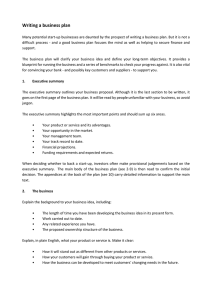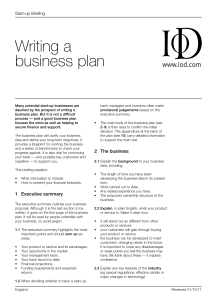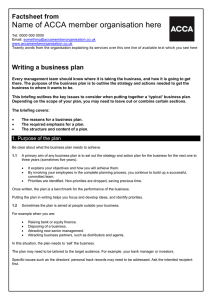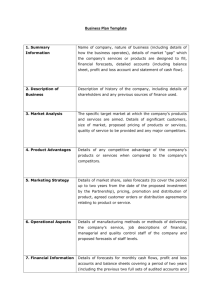Writing a business plan
advertisement
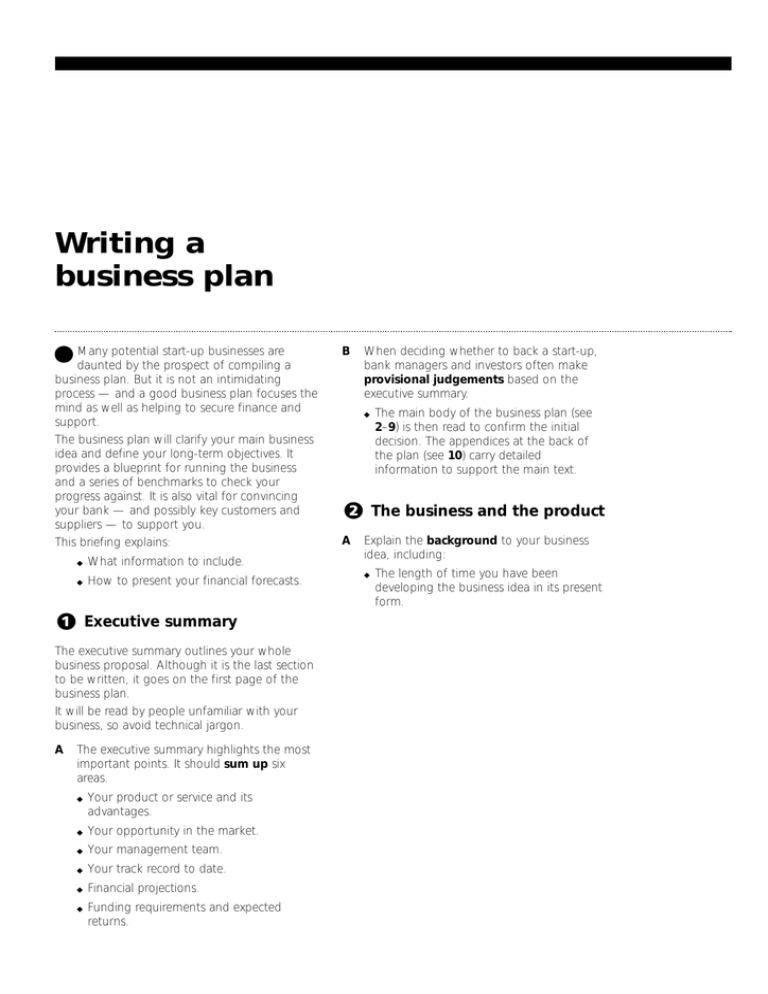
Writing a business plan Many potential start-up businesses are daunted by the prospect of compiling a business plan. But it is not an intimidating process — and a good business plan focuses the mind as well as helping to secure finance and support. The business plan will clarify your main business idea and define your long-term objectives. It provides a blueprint for running the business and a series of benchmarks to check your progress against. It is also vital for convincing your bank — and possibly key customers and suppliers — to support you. This briefing explains: ◆ What information to include. ◆ How to present your financial forecasts. Executive summary The executive summary outlines your whole business proposal. Although it is the last section to be written, it goes on the first page of the business plan. It will be read by people unfamiliar with your business, so avoid technical jargon. A The executive summary highlights the most important points. It should sum up six areas. ◆ Your product or service and its advantages. ◆ Your opportunity in the market. ◆ Your management team. ◆ Your track record to date. ◆ Financial projections. ◆ Funding requirements and expected returns. B When deciding whether to back a start-up, bank managers and investors often make provisional judgements based on the executive summary. ◆ The main body of the business plan (see 2–9) is then read to confirm the initial decision. The appendices at the back of the plan (see 10) carry detailed information to support the main text. The business and the product A Explain the background to your business idea, including: ◆ The length of time you have been developing the business idea in its present form. B C ◆ Work carried out to date. ◆ Any related experience you have. ◆ The proposed ownership structure of the business. Explain, in plain English, what your product is or what your service offers. Make it clear how: ◆ Indicate how large each market segment is and whether it is growing or declining. ◆ Illustrate the important trends — and the reasons behind them. ◆ Outline the key characteristics of buyers in each segment (eg age, sex or income). ◆ Mention customers you have already lined up and any sales you have already achieved. ◆ It will stand out as different from other products or services. ◆ Your customers will gain through buying your product or service. ◆ The business can be developed to meet customers’ changing needs in the future. ◆ List the advantages and disadvantages of all your competitors and their products. It is important to cover any disadvantages or weak points you feel the business may have. Be frank about these — it actually inspires confidence. ◆ Explain why people will desert established competitors and buy from you instead. ◆ Show you understand your competitors’ reaction to losing business and demonstrate how you will respond to it. Explain any key features of the industry (eg special regulations, effective cartels or major changes in technology). Markets and competitors A Focus on the segments of the market you plan to target — for example, local customers or a particular age group. B What are the competing products and who supplies them? Unless there is a viable market and you know how you are going to beat the competition, your business will be vulnerable. You must show you have done the market research needed to justify what you say in the plan (see Researching your market, SuB 3). Sales and marketing Keep it real This section is crucial. It often gives a good indication of the business’s chances of success. Sales forecasts produced for start-up businesses are often wildly over-optimistic. Here are some important reality checks. A How will your product or service meet your customers’ specific needs? B A How soon can you start selling? ◆ B C ◆ This is the place to show how your price, quality, design features, response time and after-sales service will compare with competitors. ◆ Quote minimum order figures, if appropriate. Will potential customers hold off for a year before they take you seriously and place an order? How often will you be able to sell? ◆ How will you position your product? How many days a year can you spend selling? ◆ How long will each lead take to line up? ◆ What percentage of leads will turn into sales? C How will you sell to customers? For example, by phone, through your website, face-to-face or through an agent. ◆ The key sales points for your product or service (see Marketing your business, SuB 4). ◆ Show how long you predict each sale will take. Many new businesses underestimate the time involved in winning each order. In year one you may spend up to 80 per cent of your time making contacts and selling. ◆ Will you be able to make repeat sales? If not, it will be hard to build up volume. How much will you be able to sell? ◆ What will the average sale value be? ◆ Will most people give repeat orders, or must you find a new customer for every sale? D How long after a sale will it be before you can collect payment? In the light of all this, how much income can you realistically expect each month? page 2 D Who will your first customers be? ◆ Show which customers have expressed an interest or promised to buy from you and the sales they represent. ◆ How will you identify other potential customers? Unless you can demonstrate that you have a clearly defined pool of potential customers, starting your business is likely to be a struggle. E How will you promote your product? For example, using advertising, PR, direct mail or via email and a website. F What contribution to profit will each part of your business make? ◆ will want to be sure you are committed to the business. Show how much time and money each of the management team will contribute, and what your salaries and benefits will be. Operations Explain what facilities the business will have and how it will deliver the product or service to the customer. A Show the pros and cons of the location. B Most businesses need more than one product, more than one type of customer and more than one distribution channel. ◆ Look at each in turn. Examine your likely sales, gross profit margins and costs. ◆ Identify where you expect to make your profits and where there may be scope to increase either margins or sales. Services and intangible products (eg computer software) are more difficult to market. Start-ups in these areas must pay special attention to marketing in their business plans. Indicate the facilities you will need to start (eg equipment and machinery). Some startup businesses only need a desk and a phone. ◆ C Provide a list of employee roles you need to fill and the skills required to fill them. D Show how you have selected your suppliers. Management People reading the business plan need to be given an idea of why they should have faith in the management of your start-up operation. A Outline the management skills within your team. ◆ Define each management role and who will fill it. ◆ Show your strengths and outline how you will cope with any weaknesses. ◆ Describe the background and experience of each team member. ◆ Clarify how you intend to cover the key areas of production, sales, marketing, finance and administration. ◆ ◆ B How committed are you? ◆ Financial forecasts Your financial forecasts translate what you have already said about your business into numbers. A A realistic sales forecast forms the basis for all your other figures. ◆ B Management information systems and procedures should be outlined. For example, management accounts, sales, stock control and quality control. Show how many ‘mentors’ and other supporters you will have access to. Banks and any other potential investors Consider any potential limits to production capacity. If you are going to manufacture or distribute products, show how and where you are going to warehouse them and for how long. C Break the total sales figure down into its components (eg different types of products or sales to different types of buyer). Your cashflow forecast shows how much money you expect to be flowing into and out of your bank account and when. You must show that your business will have access to enough money to survive. ◆ Demonstrate that you have considered the key factors affecting cashflow — eg level and timing of sales revenue, wages. ◆ Show when there will be more money coming in than going out (‘cash-positive’). Your profit and loss (P&L) forecast gives a clear indication of how the business will move forward. Summarise the annual P&L forecast for each of the two or three years of trading. page 3 ◆ Calculate the turnover you need to break even: £ breakeven ✕ 100 If your gross margin is 25 per cent, your sales must be four times as large as fixed costs to break even. ◆ ◆ These will show you the financial state of your business on day one and at each year end, perhaps for the first two or three years. Appendices A Detailed financial forecasts (monthly sales, monthly cashflow, P&L, any balance sheets) should usually be put in an appendix. ◆ Do not get too protective about your forecasts. You may need to revise them. For every forecast, list all your key assumptions (eg prices, sales volume, timing). Small business advisers at banks, Business Link and Enterprise Agencies will often help you put together your forecasts free of charge. B Financial requirements The cashflow forecast will show how much finance the business needs. Your assessment of the risks will determine whether or not you need to arrange contingency financing. B State what the finance will be used for. ◆ C Show how much will be for buying equipment and how much for working capital (financing stock and debtors). ◆ Detailed CVs of key personnel (essential if you are seeking outside funding). ◆ Market research data. ◆ Product literature or technical specs. ◆ Names of target customers. ◆ A list of external data sources used in your research will add credibility to the information. Presenting the plan The more solid information you can gather for your own use, the better the business plan will be. But a banker or other outsider will not have time to read through all the details. A Keep your business plan short. Confirm that you will be able to afford it. For example, if you want a loan, will your business generate the cashflow to make the capital and interest payments? ◆ B Assessing the risks A Look at the business plan and isolate areas where something could go wrong (eg if your main supplier closes down). ◆ B ◆ C You can arrange contingency funding to Most business plans are too long. Focus on what the reader needs to know. Make it professional. ◆ Put a cover on the business plan and give it a title. ◆ Include a contents page. Test it. ◆ Re-read it yourself. Would reading your plan give an outsider a good feel for your business and a grasp of the key issues? ◆ Show the plan to friends and expert advisers and ask them for comments. The time you spend rewriting and polishing the plan now will save you time later, when you are arranging finance and launching your business. What you would do if it actually happens? Consider a range of what-if scenarios (eg what happens to your cashflow if sales are 20 per cent lower or 15 per cent higher than forecast?) If there are serious risks: Include a detailed list of assumptions. For example, the profit margin on each product, debtor collection period, creditor payment period, stock turn, interest and exchange rates, funding injections, equipment purchases. You may want to give other relevant information. A Say how much finance you will want, when and in what forms. For example, you might want a fixed-interest loan and an overdraft facility. You may decide that the business is too risky and abandon the whole project. Assessing risk clearly will help you minimise problems and help build up your credibility with any investor or bank. Compare the breakeven level of sales with the sales you are forecasting. D If you are launching a larger start-up, you will also need projected balance sheets. E cover the finance you may need. page 4
